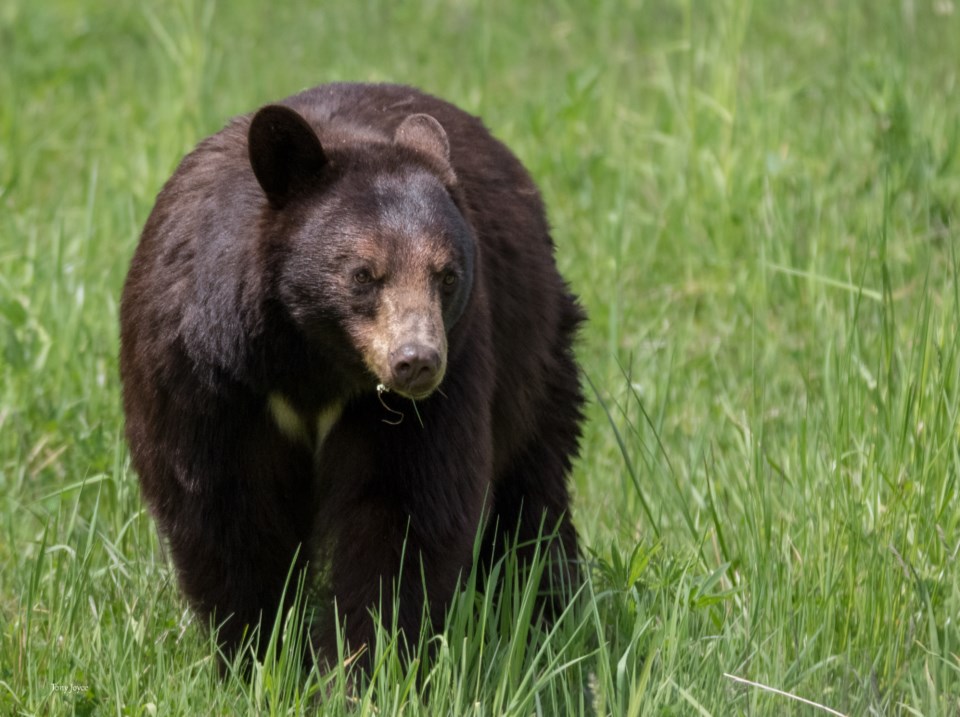Hello spring! The flowers are thinking of blooming and our furry neighbourhood bears are emerging from their dens. Expect to see them crossing roads, on trails, and passing through town.
After barely any time resting, black bears are awake—albeit a little sluggish. Adult males are the first to emerge, followed by females, juveniles and lastly, new moms with cubs. Bear cubs born the previous winter (now yearlings) spent a busy season learning, exploring, and navigating life living close to humans. These young bears need to arise well-rested as spring dispersal is looming, and soon, they will live independently of mom.
Winter-killed animals provide important protein for male bears who rise in late winter. Though their diet is 80-per-cent vegetation, black bears have the digestive system of a carnivore and prefer to consume new growth, when young shoots are most nutritious and digestible. Grasses, sedges, dandelions and horsetails are important protein-rich foods that bears will seek out before berries arrive.
During this time of low food availability, new cubs stay nourished thanks to their mother’s rich milk, and adults rely on the fat reserves they built during hyperphagia the previous fall.
In the neighbourhood
During this first stage of being awake from hibernation, bears are not as consumed by the need to find food as they were in the fall, and they will be mostly seeking out fresh greens. Although our responsibility when we share the landscape with bears begins right now by making sure we have no food available for them around our homes.
Given the opportunity, bears will be tempted by unsecured garbage, pet food, bird feeders and the food delivery order that awaits you at your doorstep. Once consumed, these high-calorie foods will keep bringing bears back to homes, contributing to their untimely and avoidable deaths.
It is important that we set boundaries by not inviting bears to our homes with food and encouraging them to move on (from a safe place) if they visit. When you see a bear on your property, go to a window or deck and use a firm, persistent tone to encourage them to leave. Bears understand where they are not welcome, providing you are not confusing them with tempting treats.
Bears crossing
Foraging for spring greens brings bears to the roadside, where such food is plentiful. Be alert for all wildlife when driving. If you see a bear on the roadside, slow down and give the bear ample space—but please, do not stop. Approaching bears and turning off our engines contributes to bears feeling more comfortable around vehicles, greatly increasing their chances of being hit.
On the trails
Help to avoid surprise encounters on the trails by making noise with your voice. Whilst the sound of a bear bell is better than silence, it does not travel far or identify you as human. Call out often in a firm tone as you explore. Be slower and louder by water and in low visibility areas.
If you see a bear ahead in the distance, calmly leave the area and take an alternate route. Give bears the space they need to forage and teach their cubs vital survival skills. Be aware of your surroundings in all directions as you leave.
If you encounter a bear: be present, stay calm, talk to them in a calm voice (any language to identify yourself as human), prepare your bear spray and slowly back away. In most cases, when you start speaking to a black bear, they leave the area or climb a tree to safety. Calmly distance yourself.
Bear in mind
Bears are part of our wider community, and though they are particularly visible in Whistler, they are not domesticated. Do not approach them, especially for photographs. Bears won’t appreciate you intentionally encroaching on their personal space—who does!
Every new season offers us an opportunity to show bears that their lives have value by being responsible and respectful residents and visitors of bear country.
Luci Cadman is certified in bear safety and awareness and is a certified bear-viewing guide with the Commercial Bear Viewing Association of British Columbia. She has been the Education Coordinator for the North Shore Black Bear Society for five years and is now the Executive Director. While bears remain Luci’s first love, she expanded the Society’s educational outreach in 2018 to include coyotes, bobcats and cougars.




